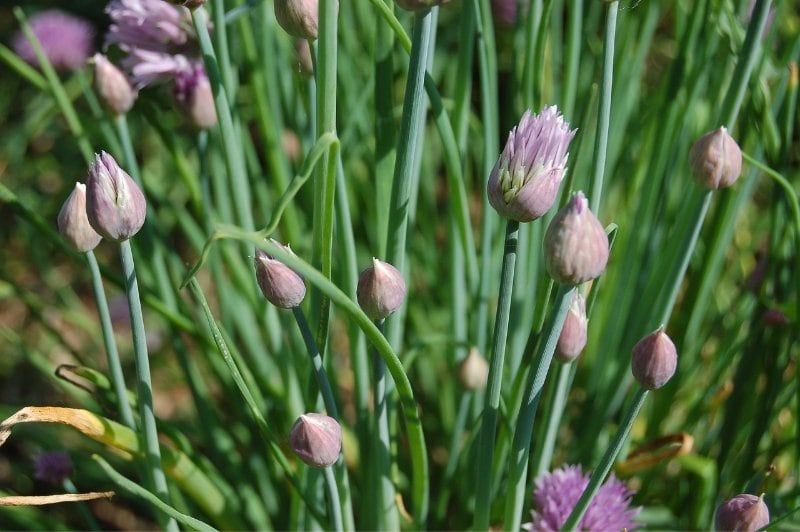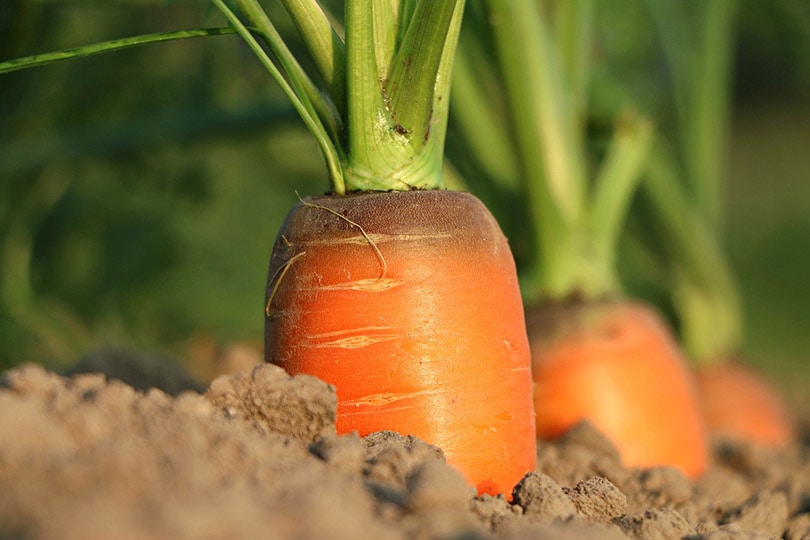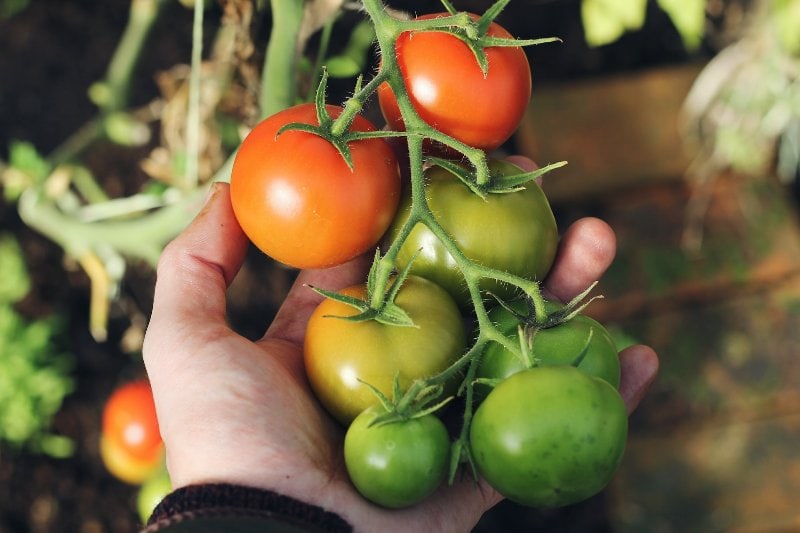7 Companion Plants For Chives (With Pictures)
-
- Last updated:

It’s hard to hate a plant as patient and generous as chives. As a low-maintenance herb, this perennial thrives in moist, rich soil up to USDA zone 3, allowing gardeners from all over a chance to enjoy its many benefits. At the dinner table, chives add zing to meats, cheeses, soups, salads, and more, and the gorgeous lavender flowers in the fall offer a dazzling highlight for the garden.
Chives provide a lot to appreciate, but we aren’t the only ones benefitting from their presence.
The pest-deterring plant is an excellent companion plant for several common cool-season garden vegetables. Planted alongside chives, many of your favorite foods gain the best chance for survival and abundant growth. Find out which ones in this look at the best companion plants for chives.

The 7 Companion Plants For Chives
1. Carrots

| USDA Hardiness Zone: | 3–10 |
| Soil and Sun: | Sandy, well-drained soil; Full sun |
Carrots and chives are perfect partners in the garden. The onion aroma of chives deters aphids and carrot flies that could potentially damage your crop, and they can even help repel those prototypical carrot consumers, rabbits.
Pest protection is vital for many gardeners, but the benefits of carrots don’t end there. Chives have shallow root systems that allow carrots to develop undisturbed and provide a flavorful boost to the root vegetable. Carrots will have a sweeter, richer taste and grow larger when paired with chives.
2. Lettuce

| USDA Hardiness Zone: | 2–11 |
| Soil and Sun: | Rich, well-drained; Full sun/partial shade |
Lettuce also enjoys the aphid-repellent properties of chives, as its strong-scented neighbor will mask its aroma. Most veggies get along with lettuce, letting you plant it alongside other great chive companions, like carrots and radishes. Add chive plants between lettuce rows to keep pests away.
3. Cabbage

| USDA Hardiness Zone: | 1–9 |
| Soil and Sun: | Moist, rich, well-drained; Full sun |
Cabbage isn’t ideal near lettuce plants, as it can prevent proper germination, but chives fare perfectly fine around it. Brassica plants generally benefit from chives and each other in their own garden space. Use chives to keep cabbage maggots and other pests away from broccoli, kale, cauliflower, mustard, and kohlrabi.
As with carrots, cabbage gets a flavor enhancement from the close pairing with chives, and the two make for an attractive aesthetic in the garden.
4. Tomatoes

| USDA Hardiness Zone: | 5–11 |
| Soil and Sun: | Moist, rich, well-drained; Full sun |
Tomatoes love the protection from aphids and other pests that chives provide. But the hardy Allium also sets tomato plants up for more successful fruiting. Chives are easy-going and willing to let tomatoes suck up the nutrients necessary to thrive, and they can even improve the flavor and yield of your crop.
When chives flower in mid–late spring, they’ll attract essential pollinators that can help the initial tomato plant flowering. Plant them around the perimeter of your tomato bed to aid your plants and create a colorful arrangement with the purple and white flowers complementing the vibrant tomato plants.
5. Strawberries

| USDA Hardiness Zone: | 5–10 |
| Soil and Sun: | Sandy/loamy, rich; Full sun |
The delectable sweetness of strawberries can be all too tempting for garden pests, so some well-placed chives may be crucial in keeping them safe. They’ll cover the sweet smell emanating from the fruit and invite beneficial bugs into the garden, including pollinators and ladybugs.
Like many other plants, strawberries earn a healthy nutrient boost from chives. Many recommend fertilizing with a “chop and drop” method of trimming chives and leaving them on the soil around the strawberries to increase yields.
6. Grapes

| USDA Hardiness Zone: | 4–10 |
| Soil and Sun: | Well-drained, loamy, rich; Full sun |
We may not think of them as compatible in the kitchen, but, like strawberries, grapes are an excellent fruit companion plant for chives. The herb attracts pollinators and deters pests, giving your grapes the best chance for abundance.
A late-season variety like garlic chives could supply a beautiful juxtaposition against the vibrant purple of the grapes. Grape vines typically take 3 years to fruit. Early planting of the perennial chives will give them much-needed assistance growing to their fullest potential.
7. Apple Trees

| USDA Hardiness Zone: | 5–8 |
| Soil and Sun: | Moist, well-drained; Full sun |
Chives are a massive help for fruit trees, particularly apple trees that can fall victim to apple scab, a fungal infection causing defoliation and fruit drop. Roses develop similar infections, which is why chives often make a beautiful and beneficial addition to flower gardens. Apple trees will also get odorous protection against deer and apple tree borers that could quickly tear through a crop or even kill young trees.

Why Chives Are a Great Companion Plant
Chives are exceptional companion plants for nearly any vegetable, fruit, or flower, primarily because of their pest-deterrent qualities. The pungent onion scent of the sulfur-based oils in chives repels pests like aphids, mites, and Japanese beetles. Garden nuisances like deer and rabbits also don’t care for the scent of Alliums. At the same time, the late spring–early summer flowers draw in numerous beneficial bugs like butterflies, bees, ladybugs, and beneficial wasps.
The long growing season also gives you a convenient fertilizing mulch for the plants that chives protect. Chives accumulate potassium and calcium, vital nutrients to help your plants grow. When you trim the plants, you can drop the leaves on the ground around your other vegetables to feed them.
Chives generally make great filler plants, not only for their nutrient value and pest deterrence but also for their growth habits. They are an excellent ground cover, helping to keep weeds out, retain moisture, and cool the soil. Garlic chives can be invasive, but regular chives have a controllable clumping habit that fits nicely among other plants.
Plants That Aren’t Good Companions for Chives
Chives are generally agreeable to other plants, but a few vegetables won’t enjoy being near them or any plant in the Allium family. Asparagus and spinach won’t grow as vigorously when they compete with chives for nutrients. Chives also have antimicrobial properties that can hinder the nitrogen-fixing capabilities of legumes.
Other plants can damage chives. Peas are allelopathic, meaning they release chemical compounds into the ground that can potentially harm your chives. Meanwhile, some herbs like rosemary, thyme, and sage don’t have soil and watering requirements that align with chives, making them impractical to grow together.

Conclusion
Store-bought fresh herbs can be expensive, and chives are too low-maintenance and advantageous to leave out of the garden. From the flowers to the flavors, chives are an all-around pleasure. Plant them with these willing companion plants, and you’ll enjoy more benefits than you ever thought possible!
Featured Image Credit: BARBARA808, Pixabay
Contents

